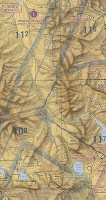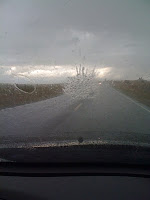
I have to admit to being a little disingenuous with my
last post discussing the perils of the glass cockpit, because even as I wrote it I knew that I was planning to buy a new portable GPS to replace my beyond-aging Trimble Flightmate, whose database expired in 1995. The Flightmate worked fine as a GPS: its position, track, and groundspeed estimates were as good as any of the more more modern units, even without WAAS. But Trimble no longer supports the unit, so no database update is available. There is no moving map, although I still say that I don't need a moving map. And, worst of all, the older chip uses a lot more power than a modern chip, so battery life is poor, and the Trimble had a really clunky power cord that was always in the way.
In my mind, the position sensor is irrelevant: what we do now is
database navigation, not GPS navigation. Pilots need to think about the flight as a whole, not as the next fix, and the habit of thinking a flight through will carry over into more advanced flying.

So yesterday's UPS brought me a new Garmin Aera 500 and an excuse to go flying. Knowing the perils of head-down time, I invited an advanced student to ride along, as well as my son.
The unit just blew me away, in the good sense. The yoke clip fits intuitively, with no restriction on the controls. There is only one cord, which is built in to the yoke clip (nobody has mentioned this, and I think it's a terrific idea), so the cockpit no longer resembles the floor of an Italian restaurant at the end of a long night of dropped spaghetti.
I found it easy to program, and it has all of the approach intersections, although not the full procedures (more on this later). Its terrain warning module stays in the background until there's a problem, when a window pops up with red and yellow warnings and Xs to mark where you will hit. While there are some problems with this, of which I've been aware for a long time; see my essay in
RISKS 19.56, I am convinced that it still leaves us better off than we were before.
Part of my prepurchase debate with myself was the following: the cost of these units approaches the cost of used panel-mount IFR GPS, with which I could
file IFR; the aera is definitely not for IFR. But an informal poll of the members of my flying club led to the conclusion that we are a VFR club. Only two other members are instrument-rated, and neither of them is current. So the improved navigation is something that I want, not the club.
The thing is, you can still use the aera to
monitor an instrument approach. It doesn't do all the things that an IFR unit would do, nor is it legal even if it did. The aera will put the final approach waypoint and the missed approach point into the flight plan, but the Aeronautical Information Manual is very clear that we can only fly IFR approaches retrieved from the database. Still, if you insert the transition waypoints into the flight plan and get yourself on a segment before "loading" the approach, the fixes are all there.
I see a lot of training value in this. A student under VFR can load the approach (using almost the same keystrokes as in the panel mount Garmins) and practice, say, an area arrival. The instructor can ask the student to make the same calls (for example, "Approach Active" when 2NM from the FAWP). The student has to recognize the step-down fixes and read the chart to fly the appropriate altitude. It may not
count as an RNAV approach, but the student gets the experience and will be much closer to the Escoffier standard of instrument proficiency when he or she moves up.
I think you can teach someone almost all of the ins-and-outs of a modern glass panel with the unit. I tcompares well with the various IFR GPS units I've used, and even the UNS-1 I flew in a King Air. In some ways its terrain display is more intuitive than the one in the King Air, which didn't do anything except squeek "terrain" at awkward moments unless you chose that page on the MFD.
In my case, teaching at a school with no glass cockpits and no panel mount GPSs in the trainers, this may be the only way I have to get a student to learn something about 21st century navigation.
With the Trimble, I could only teach 20th century navigation.
Labels: Escoffier, glass, GPS, Terrain

 Even sillier was the the AOPA Internet Flight Planner, which proposed a 2001 NM odyssey that went well into British Columbia.
Even sillier was the the AOPA Internet Flight Planner, which proposed a 2001 NM odyssey that went well into British Columbia. 








